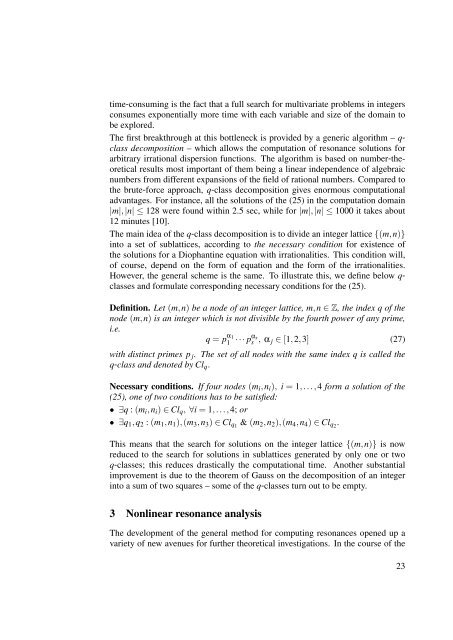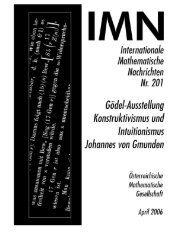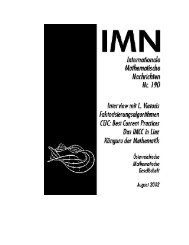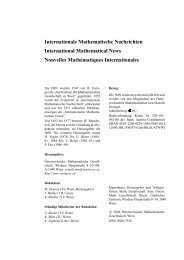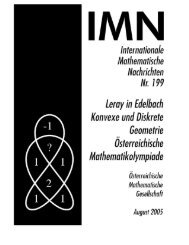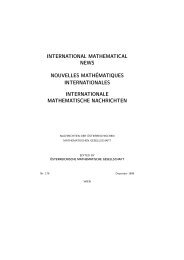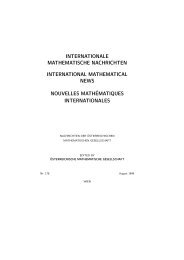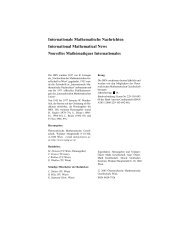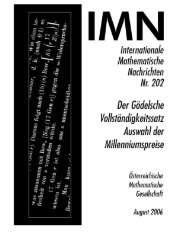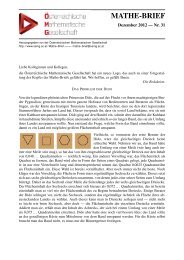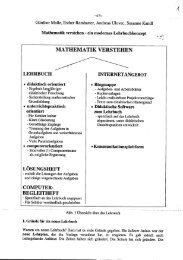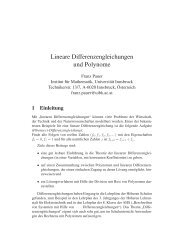218 - Ãsterreichische Mathematische Gesellschaft
218 - Ãsterreichische Mathematische Gesellschaft
218 - Ãsterreichische Mathematische Gesellschaft
Erfolgreiche ePaper selbst erstellen
Machen Sie aus Ihren PDF Publikationen ein blätterbares Flipbook mit unserer einzigartigen Google optimierten e-Paper Software.
time-consuming is the fact that a full search for multivariate problems in integers<br />
consumes exponentially more time with each variable and size of the domain to<br />
be explored.<br />
The first breakthrough at this bottleneck is provided by a generic algorithm – q-<br />
class decomposition – which allows the computation of resonance solutions for<br />
arbitrary irrational dispersion functions. The algorithm is based on number-theoretical<br />
results most important of them being a linear independence of algebraic<br />
numbers from different expansions of the field of rational numbers. Compared to<br />
the brute-force approach, q-class decomposition gives enormous computational<br />
advantages. For instance, all the solutions of the (25) in the computation domain<br />
|m|,|n| ≤ 128 were found within 2.5 sec, while for |m|,|n| ≤ 1000 it takes about<br />
12 minutes [10].<br />
The main idea of the q-class decomposition is to divide an integer lattice {(m,n)}<br />
into a set of sublattices, according to the necessary condition for existence of<br />
the solutions for a Diophantine equation with irrationalities. This condition will,<br />
of course, depend on the form of equation and the form of the irrationalities.<br />
However, the general scheme is the same. To illustrate this, we define below q-<br />
classes and formulate corresponding necessary conditions for the (25).<br />
Definition. Let (m,n) be a node of an integer lattice, m,n ∈ Z, the index q of the<br />
node (m,n) is an integer which is not divisible by the fourth power of any prime,<br />
i.e.<br />
q = p α 1<br />
1 ··· pα s<br />
s , α j ∈ [1,2,3] (27)<br />
with distinct primes p j . The set of all nodes with the same index q is called the<br />
q-class and denoted by Cl q .<br />
Necessary conditions. If four nodes (m i ,n i ), i = 1,...,4 form a solution of the<br />
(25), one of two conditions has to be satisfied:<br />
• ∃q : (m i ,n i ) ∈ Cl q , ∀i = 1,...,4; or<br />
• ∃q 1 ,q 2 : (m 1 ,n 1 ),(m 3 ,n 3 ) ∈ Cl q1 & (m 2 ,n 2 ),(m 4 ,n 4 ) ∈ Cl q2 .<br />
This means that the search for solutions on the integer lattice {(m,n)} is now<br />
reduced to the search for solutions in sublattices generated by only one or two<br />
q-classes; this reduces drastically the computational time. Another substantial<br />
improvement is due to the theorem of Gauss on the decomposition of an integer<br />
into a sum of two squares – some of the q-classes turn out to be empty.<br />
3 Nonlinear resonance analysis<br />
The development of the general method for computing resonances opened up a<br />
variety of new avenues for further theoretical investigations. In the course of the<br />
23


